
6 Super Land Animals From Africa and South America
Animals are extraordinary. Their incredible diversity makes it almost impossible for us to keep track of them all. Scientists could only name 1.2 million species, both living and extinct. However, this number seems quite small compared to the total number of species scientists have estimated. According to them, there are more than 8.5 million species on Earth. Insane, is it not?
Studying animals, despite being hard work, is so much fun. It is a window to a whole new world of real superpowers which we humans lack and cannot help fixate on.
That is why, in this article, we are talking to you about six marvellous animals currently living on Earth.
So let’s hop into it.
(1) The Tallest: Giraffe
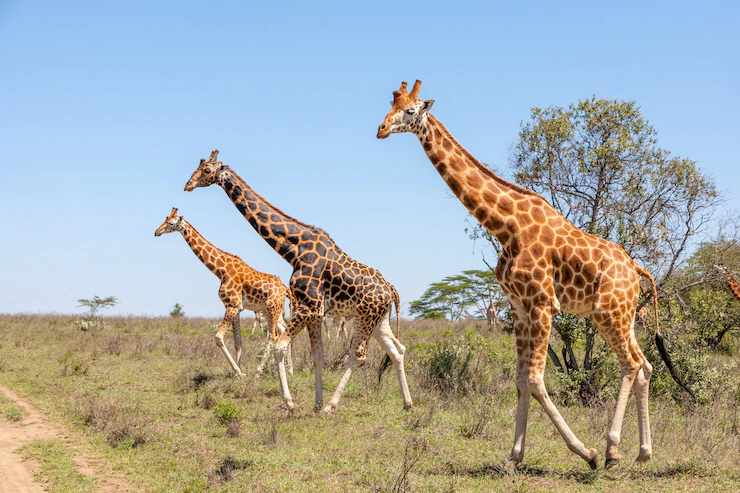
Though many species may look alike or at least have similar body structures, giraffes stand out as one of the most unique, enchanting, and attractive animals out there.
Giraffes are the tallest animals ever found on Earth. They live exclusively in Africa. More precisely, large populations of giraffes are found in open woodlands and savanna in east and central African countries including Niger, Chad, Sudan, Cameroon, Ethiopia, and Uganda.
Interestingly, the name giraffe is derived directly from the Arabic name ‘zarafah’, used to refer to the same animal. At first, it used to be spelt ziraph. However, changes in the English language and influences from other languages such as Italian and French have made the spelling settle to giraffe.
Appearance of the Giraffe
No one can deny how good-looking giraffes are. Not only does their height make them distinct, but also the dark brown patches on their orange coats create strikingly beautiful unique patterns.
Like with many other animals, there are some small differences between male and female giraffes. First off, their names. Male giraffes are usually called bulls while females are referred to as cows.
An adult male giraffe is 5.7 m tall while a female’s maximum height is 4.3 m. According to Guinness World Records, the tallest living giraffe is a male called Forest. He was found to be 5.7 m tall. He lives in an Australia Zoo in Queensland, Australia.
Unlike how fit they might look, giraffes are pretty heavy. A male giraffe weighs 1,192 kg on average while a female’s mean weight is 828 kg. Giraffes also have long thin black tails extending for 80-100 cm and ending with a tuft of dark hair.
Besides weight and height, another distinct feature that sets males and female giraffes apart is colour. Males are usually darker than females in adulthood.
Thanks to their height and strong bodies, giraffes can usually survive attacks. That makes them enjoy a long lifespan of 38 years at maximum. That said, baby giraffes are easier prey for predators, especially the big cats including leopards and lions who are also native to Africa.
Speaking of the body itself, giraffes have a dark coat of fur with patterns of patches of colours ranging from orange, brown, to sometimes even black. These patches are separated by cream-coloured hair. And just like no two ginger cats have the same fur patterns, every giraffe’s coat pattern is unique.
What is also fascinating about giraffes is that the skin under the fur coat helps keep their body temperature at a certain, suitable degree that is not affected by how hot or cold it gets.
Both males and females have two short horn-like bone structures in their heads called ossicones. Though their ears are small, giraffes enjoy very sharp hearing abilities.
In addition, giraffes have relatively small, cut-in nostrils. They are believed to protect the giraffes from blowing sand. Giraffes can also smell very well. Another unique feature is their eyes. Giraffes have an eye on each side of the face. Thanks to their height, this pair of eyes provide good vision over a wide field.
Besides, giraffes have a 45-cm long, black tongue and an upper lip that is a little longer than the lower lip.
Neck and legs
Now to the two most distinctive features of giraffes: the neck and legs.
A giraffe’s average neck length is 1.8 m but it can grow to as tall as 2.4 m. Typically, an adult giraffe’s neck rests when titled at 55° on average. On the other hand, a younger giraffe might tilt its neck at 70d° comfortably.
The neck is also covered with the same orange/brown patches but features a mane of short brown fair hair.
Similarly, giraffes’ legs are quite long. The front and back legs are about the same length of around 1.8 m. Giraffes have hooves as well as a unique leg bone structure that helps support the giraffe’s heavy body. Such strong legs also make a powerful weapon for the giraffe as well. During fights with other giraffes or predators, giraffes can kick their enemies really powerfully.
Though they often look relaxingly walking and wandering around looking for food, giraffes are fast runners. Thanks to their long lanky legs, giraffes can run at speeds of 60 km/h for short distances and 50 km/h for longer distances. That is the same as the running speed of a Bengal tiger! But unlike Bengal tigers, giraffes are not very good swimmers due to their body structures. However, they can easily float in the water.
Giraffes: Feeding and breeding
Giraffes feed mainly on tree twigs which they prefer as they are quite rich in protein and calcium. They also eat small-sized woody plants, leaves, grass, and fruit. Because they need to sustain their fast growth, giraffes typically eat 34 kg of food on a daily basis. Sometimes they also chew old bones and tree bark.
Usually, female and male giraffes can mate when they are around five and seven years old respectively. There is no specific season for breeding like with many animals. Giraffes can just mate at any time of the year.
At the time of mating, males would often join or walk around other groups to choose a female to marry. Young females are more appealing to males than older ones. Every male’s chance to win a female mainly depends on how dominant they are amongst their groups or compared to other males.
To create dominance, male giraffes usually indulge in fights using their necks. This behaviour is referred to as necking. The male who is able to keep his neck upright wins.
Sometimes these fights get more intense. On such occasions, males usually use their legs, ossicones, and their necks to defeat their rivals. In most cases, even those high-intensity fights do not lead to serious consequences. But on some rare occasions, fighting giraffes resulted in neck-breaking. Other giraffes even died.
A female giraffe stays pregnant for around 13-15 months. After that, a single calf is born. Giraffes can give birth to twins; however, this is quite rare. A giraffe calf, whether male or female, can be up to 2 m tall. They can walk and even run right after birth but they do not. They hide until they get used to the new world. That usually lasts for one to three weeks. Interestingly, their beautiful coat patterns provide camouflage so it is easy to stay undistinguished for such a long period.
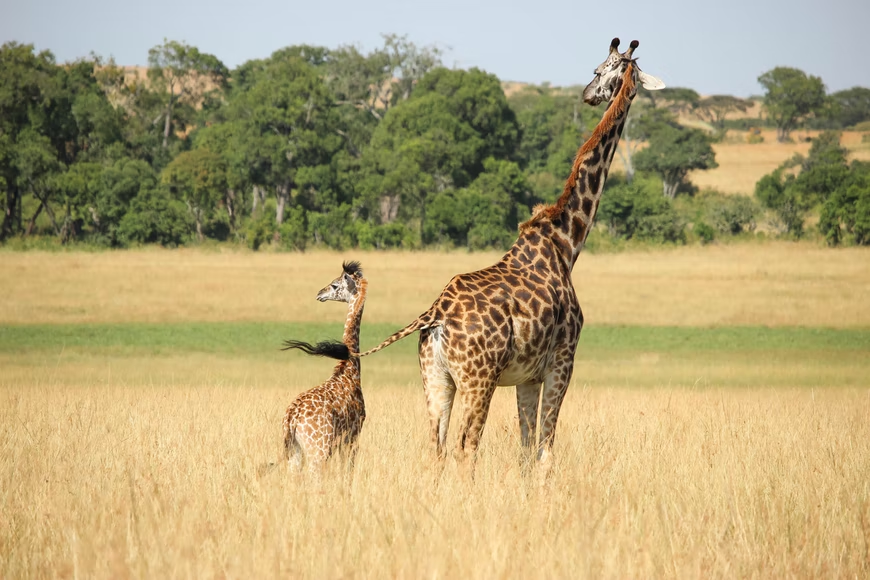
Giraffe mothers take full responsibility for feeding and raising up their calves. Giraffe fathers almost play no role in the upbringing of their children except for playing or friendly interacting with them.
Within six to eight months of birth, calves usually stop nursing. But they do not leave their mothers until they are over a year old.
Giraffes: Social life
Like elephants and monkeys, giraffes are usually found in groups. However, it is the structure of such groups that is different. In a monkey troop, there is a highly organised structure and social ranking. Usually, the oldest, strongest, and the most aggressive male monkey is the alpha of the troop. With giraffes, it is way more simple and even more random than that.
In fact, a group of giraffes does not have a consistent structure that researchers nor anthropologists could agree on. A group can be some giraffes less than a kilometre apart and not moving away from one another.
Sometimes groups include giraffes of the same blood or gender. That means giraffes of the same family may form a group of their own. Similarly, there can be female-only or male-only groups. There are also mixed-sex groups.
Generally speaking, groups are more likely to have mothers and their offspring, whether males or females. When male giraffes grow up, they tend to leave their groups and join other female or mixed groups. Adult male giraffes also tend to wander far away from where they usually live with other members of their groups
Interestingly, giraffes seem to get together or separate based on the weather. For instance, they spread out and wander far from one another usually during the wet season; when there is a lot of food. This often lasts for six to eight months. However, in the dry season, food is scarce. So giraffes gather around and eat together.
Speaking of trust-based friendships, mother giraffes seem to have strong bonds with other females of the same group. That clearly appears in them leaving their calves to their female friends while they go drink or eat somewhere else.
Giraffes: Threats
Poaching is known as the illegal hunting and killing of animals to take advantage of their meat, fur, bones, and other body parts. Like many other animals, giraffes have been prone to poaching all across Africa.
Besides poaching, giraffes’ numbers are declining because of the loss of their habitat. A habitat is an area in the wild where an animal can survive, flourish, and breed. When humans cut trees, which is an activity known as deforestation, the giraffes’ food source decreases. This results in the animal moving away to look for food in other places. Otherwise, it may starve.
Such activities have decreased giraffes’ numbers dramatically. For instance, at some point in time, there used to be around 155,000 giraffes. But this number declined to 97,500 in 30 years’ time.
As a result, some giraffe subspecies are classified as vulnerable. Others are near threatened, endangered, and some are even critically endangered. That means, unless the circumstances that threaten the giraffe change, the entire species might go extinct.
(2) The Slowest: Sloth
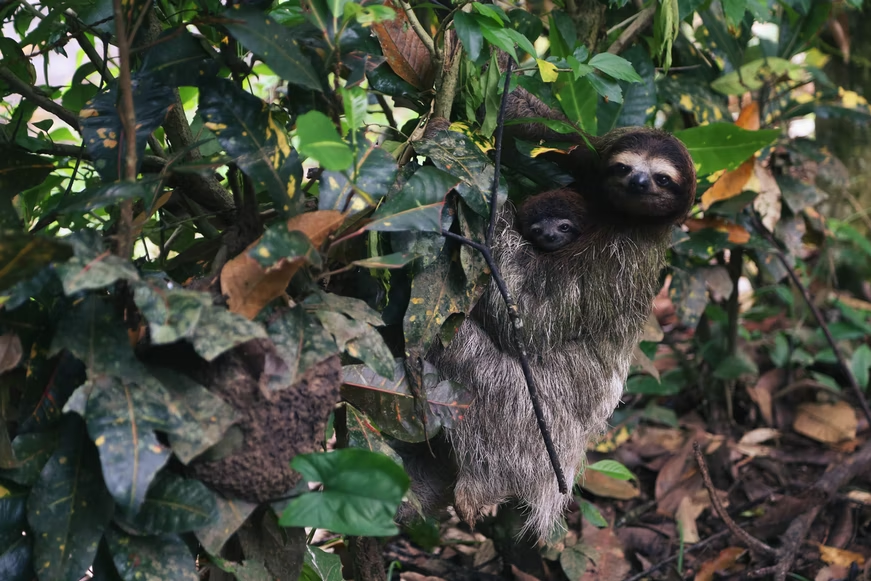
Did you happen to watch Disney’s animated film Zootopia? Do you remember that scene when Nick and Juddy went to the DMV to run the plate and they met Flash, the slow, lazy animal? This is a sloth and sloths are what we are discussing next.
The proper name ‘sloth’ directly translates to laziness. Sloths are not just slow in terms of movement. But their metabolism is slow too. That means their bodies burn calories pretty slowly.
Maybe that is why sloths are the slowest animals. Since slow metabolism causes continuous tiredness, sloths do very little physical activity, which causes them to gain weight. It seems like a vicious cycle the poor animal inevitably has to go through, day in, day out.
Other languages, such as French and Arabic, also call the animal by its very common trait: laziness.
Sloths are native to Central and South Americas’ rainforests. There are six different living species of sloths, divided into two groups. Members of the first group have two toes while members of the other group have three toes. These two groups are not completely different from one another. In fact, they are somehow related. You may think of them as distant relatives.
Appearance of the Sloth
No one can deny how good-looking sloths are. They are cute and seem happy and smiling at least when caught on camera.
While Flash from Zootopia might have appeared large or at least a normal size, sloths are relatively small. They can be 50 to 70 m long and weigh around 3.6 to 7.7 kg with two-toed sloths being a little larger than three-toed sloths. Sloths; therefore, are a little bigger than domestic cats.
Unlike many other animals, there are almost no differences between male and female sloths. Sometimes, it is even hard to tell them apart.
Sloths have a thick, brown, long-haired fur coat. They have a big flat head, big eyes, and small ears. They also have quite long, sharp, curved claws that can be up to 10 cm long. These long claws are the only thing that appears from the sloth’s body. Toes and the entire feet are hidden under the sloth’s thick fur.
One common misconception is thinking that since all animals have eyes, they must be able to see well if not have sharp vision. While this can be true in some species, it does not apply to others and sloths are one of those ‘others’.
Sloths have poor vision. They cannot also hear very well. That is why their other senses such as taste and touch are intense. They use those two senses to find food. And unlike giraffes whose skin can keep their bodies at a certain temperature despite that of the environment, sloths’ body temperature changes according to the environment. Their body temperature usually ranges between 20° to 35°, which is considered pretty low.
The Sloth: Activity
Sloths have four long, strong limbs which they use to hang on trees.
Sloths spend most of their day hanging upside down and clinging to tree branches, thanks to their strong, sharp, long claws. These claws are the reason why sloths do not spend much time on the ground. They are also so strong that even when the animal is shot dead from below by a poacher, they stay clung to tree branches.
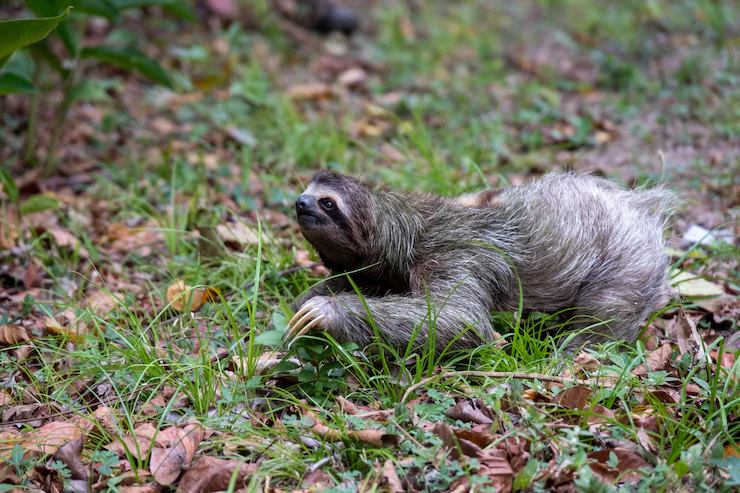
Sloths only get down from trees once every eight days. And when they do, they kind of put themselves at the risk of being preyed on by predators since they can move neither properly nor fast.
The fact that sloths spend most of their day on trees makes them somehow immune to attacks. Their thick fur coats also provide camouflage so predators cannot identify them. Even when sloths move very slowly from one branch to another, they are still unrecognisable. If they happen to encounter an attack, sloths use their claws as a weapon to either scare their attackers or wound them.
As weird as it may sound, sloths make very good swimmers. Sometimes, they get down into the water to enjoy a swim. Despite being so slow already, sloths can swim at a speed of around 14 m per minute. Being that strong swimmers make sloths also able to cross rivers.
Interestingly, sloths have a natural ability to slow down their hearts so that they beat at one-third of their normal speed. While the world record for underwater breath holding was found to be 24 minutes, sloths’ slowing down their heart rate allows them to hold their breath up to 40 minutes underwater.
That said, sloths are not really interested in moving altogether. In fact, they spend almost their entire day motionless. And when they have to move, when it is absolutely necessary for them to get around and find food, for instance, they move at a speed of four metres per minute. If they are in danger, sloths move much faster than that. They can reach 4.5 metres per minute (do I sound like making fun of sloths?!)
Surprisingly, it is not known how long sloths can live in the wild as there is a lack of studies on this very topic. But when taken care of by humans, such as in zoos and public parks, sloths live around 16 years on average.
The Sloth: Feeding
Due to their low metabolism, sloths seem to store food for longer. That results in them consuming less amount of food than other animals.
Generally speaking, sloths eat around 0.35 kg a day. Their diet generally comprises insects, fruits, and leaves as well as lizards for two-toed sloths while three-toed sloths only eat plants. The type of food sloths eat seems to affect their metabolism rate as well. For instance, leaves, which make up most of their diet, are quite difficult to digest. They also provide them with very little energy. That may explain why sloths are almost entirely motionless.
The Sloth: Social life
We can fairly say that sloths do not have any kind of social life whatsoever.
Sloths are extremely introverted. They are utterly uninterested in interacting with other sloths except when mating which we will discuss in a paragraph. This typically applies to both male and female sloths. However, females are more likely to get together.
Some three-toed sloths mate annually at the exact same time; however, others breed at any time of the year. Three-toed female sloths’ pregnancy lasts for six months only. On the other hand, the two-toed female sloths, despite being smaller, stay pregnant for about a year.
Sometimes, and due to their extreme laziness, females hate to leave the safety of their spot to find a mate and start a family! Such selfish behaviour also strangely appears in mothers and their babies. Sometimes when baby sloths accidentally fall off trees, their mothers do not come to the rescue, leaving them to die.
The Sloth: Threats
Besides natural death, sloths also die by poachers or when struck by electricity. Surprisingly, their numbers also decrease because some people catch them and sell them as pets. However, sloths do not really make very good pets, if not at all.
There are several associations that care for sloths. They keep them in captivity for a while. Then, when the sloths are fully healthy again, they are released back to their habitat in the rainforests.
(3) The Friendliest: Capybara
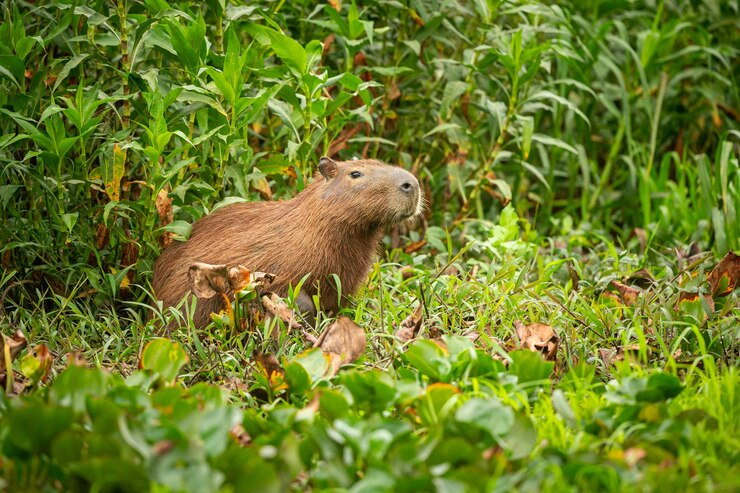
When we think of a friendly animal, we might only refer to the friendly interactions they have with us. However, the level of friendliness can also be determined by the interactions animals have with their counterparts.
Choosing the friendliest land animal is definitely disputed as everyone’s opinion will differ. While some may say it is the dog and others may cheer for their pet cat. And let’s not forget ducks, geese, and dolphins. There is a long list of animals that can be considered friendly, I know. So let’s just loosen this category a little bit and allow everyone to call whatever animal they like the friendliest.
For me, I would cheer for the capybara. I consider the capybara to be the friendliest animal on the planet.
Personally, I have not heard of the capybara before. That is why writing this part of the article was a lot more fun and I hope you find it so too.
The capybara is the largest member of the rodent family. To make it a little familiar, the rodent family includes mice, hamsters, and squirrels. Like sloths, capybaras live exclusively in South America. More precisely, capybaras are found in every country on the South American continent except for Chile. They live near rivers, lakes, and streams as well as in the savanna and dense forests.
If the capybara were lucky, it would have been named, like the sloth, after its strongest trait: friendliness. However, the name ‘capybara’ refers more to the animal’s diet. As the capybara eats grass, its name means ‘the grass eater’. Smart, is it not?!
Capybaras feed on grass, leaves, and tree bark so they are always chewing food. This makes them more prone to losing their teeth. Interestingly, if this happens, they grow new teeth to replace the ones they lost. This happens consistently.
Capybaras usually live between eight to 10 years.
Appearance of the Capybara
Belonging to the rodent family might mistakenly sound like the capybara is small-sized. However, it is not. The capybara is the world’s largest rodent. In fact, it is twice as large as the sloth.
Adult capybaras are 106 to 134 cm long and 50 to 62 m tall. They grow to be 35 to 66 kg. Despite that, a female capybara from Brazil holds a record for the heaviest capybara with a weight of 91 kg. On the other hand, the heaviest male was from Uruguay and weighed almost 74 kg.
Capybaras have a relatively small head and a short neck. The upper body is covered with a reddish, brown fur coat. However, the lower body parts lack hair.
Capybaras are very good swimmers. They can hold their breath underwater for up to five minutes. Sloth 1. Capybara 0.
The Capybara: Social life
This is one thing that shows off how friendly capybaras are.
In general, capybaras are very peaceful and quiet animals. Members of this family like to gather especially during the dry season. They form groups of 60 to 100 members.
However, capybaras usually live in smaller groups like tribes. Each of such groups has up to four adult males, seven adult females, and some young capybaras.
Males like to create social bonds with other members of the groups. They also like to establish dominance over other males. This usually happens, as we have seen with other animals, through fighting. Whoever wins the fight is considered the strongest.
Each group seems to have ranks with the strongest male being in the uppermost rank. He is also the leader of the group. The lower ranks consist of weaker, less dominant or even subordinate capybaras.
This dominance gives the male a bigger chance of being selected for mating by a female. When this happens, males like to show dominance and protect their partners. They also invite other females to the group.
Interestingly, capybaras like to engage with other animals as well. Because capybaras are naturally chilled animals, other animals feel comfortable and safe around them. Birds and tortoises, for instance, like to snuggle with the capybaras. Other animals including rabbits and even monkeys were seen to sit on capybaras, which got them the nickname ‘moving chairs.’
Many people also like to keep capybaras as pets.
The Capybara: Feeding and breeding
Capybaras mainly feed on grass, leaves, fruit, and tree bark. Interestingly, when food is abundant, capybaras seem to be quite picky about what leaves they are eating. However, when food is scarce, which usually happens during the dry season, they tend to eat whatever is available.
A female capybara’s pregnancy lasts for four to five months. On average, females give birth to five pups but they can also have only one offspring or as many as eight. At birth, pups cannot walk. But they have teeth which allow them to eat grass only within a week of birth.
That said, pubs still nurse until they are 16 weeks old. Once young capybaras can walk, they join their parents’ group and form a group within it with some other youngsters. When they turn one, young capybaras leave the group and join other groups.
The Capybara: Activity
Capybaras live both on land and in water, which they seem to favourite a lot. They can sleep in the water and around mangroves. Besides, they can submerge for as long as five minutes to hide from predators.
Though they might look chubby, capybaras are fast runners. They can run at a speed of 35 km/h. This also helps them run away from predators including jaguars, pumas, and anacondas.
(4) The Longest-Living Monkey: Baboon
I personally consider studying monkey species utterly demanding. Not only because they are too many to handle—there are a total of 334 monkey species in the world—but also because each species is incredibly distinct. Species are different in terms of size, colour, habitat, behaviour, and even interactions with human beings.
These several hundred monkey species are mainly divided into two categories: old world monkeys and new world monkeys. Despite some main biological differences between the two categories, old world monkeys live exclusively in Africa and Asia.
On the other hand, new world monkeys live in the Americas. Another feature that sets these two monkey categories apart is the nose. Old monkeys have nostrils that are close together while new world monkeys have their nostrils pointing sideways.
In a previous article on Learningmole.com, we talked about two old world monkey species native to Asia: the Japanese macaque and proboscis monkeys. Today, we are introducing another old world monkey species to you. It is not less unique than the two just mentioned nor than any other monkey species, as a matter of fact. In this section, we are discussing baboons; the longest-living monkey species.
To begin with, baboons are not just one species of monkeys but six. All of them are native to Africa with only one species found in both Africa and the Arabian Peninsula in Asia. Baboons appeared on Earth nearly two million years ago, as far as their fossils tell.
For the purpose of this article, we are going to discuss only one species of baboon: the hamadryas baboon.
Hamadryas baboon
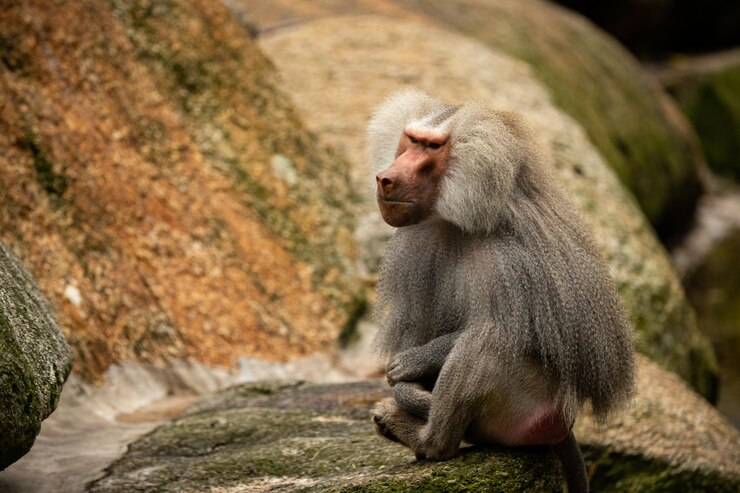
Hamadryas baboons are the only baboon species that live more to the north than the rest of the baboons in Africa. More precisely, hamadryas baboons are native to the grasslands, shrublands, cliffs, plains, and mountains of the Somali Peninsula (also known as the horn of Africa) and the southwest region of the Arabian Peninsula.
Hamadryas baboons are quite lucky to live in such a habitat for they are not as threatened by predators there as baboons in other parts of Africa. As a result, the hamadryas baboon species is not endangered, not even near threatened. That said, they are still preyed on by hyenas, African leopards, and Verreaux’s eagles
Despite their current relatively small habitat, hamadryas baboons apparently seem to have had a larger habitat thousands of years ago. For instance, they are not currently found in Egypt. But they used to live in ancient Egypt. The evidence of that is their sacred presence as a god in the ancient Egyptian culture.
Appearance of Hamadryas baboon
Interestingly, it is super easy to tell male and female hamadryas baboons apart because they are totally different in terms of colour and size. For instance, male hamadryas baboons are up to 80 cm long and weigh between 20 and 30 kg. Females, on the other hand, are roughly half of that. They have a body length of 40-45 cm and weigh a maximum of 15 kg. Both genders have a tail that ranges in length between 40 and 60 cm.
Males are characterised by having pink faces emphasised by silverish-white fur. This fur makes up a mane growing around the males’ heads and a mantle around their shoulders. These mane and mantle do not fully grow until the males are ten years old. Females do not have such capes and their entire bodies are brown-coloured.
When in the wild, hamadryas baboons live about 20 years but when cared for by humans, they can live up to 37.5 years.
Hamadryas baboons typically feed on grass, seeds, roots, and leaves. Sometimes, they may eat insects, scorpions, and lizards.
The Hamadryas Baboon: Society
As we have seen before with the Japanese macaques, monkeys tend to have a highly organised, if not complicated, social structure. This fact, in fact, shows monkeys as highly intelligent animals.
So how is it, that highly organised, if not complicated, social structure?
The main unit of a hamadryas baboon community is called one-male unit, comprising one male and up to 10 females and their offspring. This is called a harem. The male, as you must have guessed, is the leader and guard of the harm. He usually has a younger male, usually, a relative who serves as his follower, somehow like a vice president.
Relative male hamadryas baboons usually combine their harems to form a larger group called a clan.
You must be asking if a clan has multiple related males, which of them is the leader?
Well, it is the age that determines the social hierarchy of males in a clan. The oldest male is the leader. Younger males have different ranks according to their age.
Then two and up to four clans join together to form a band. A band can have up to 400 members, with power over the band being usually in the hands of males. Members in one band are closely related and they care for one another. They all eat together, sleep together, and travel together.
Now you can think of bands as united nations. Sometimes, these bands go into war with other bands to secure food and territory. Harem leaders are the ones who lead the wars with their followers being soldiers.
After that, bands join together to form a troop. The number of members in a troop may exceed 1000 individuals.
To sum up, a hamadryas baboon society is a multilevel one: harem, clan, band, and troop.
The Hamadryas Baboon: Social behaviour
Now let’s go back a little to the first one-male harem and explore the behaviour of its members.
A harem is typically a strictly conservative small society over females. Female hamadryas baboons are only allowed to move within some geographical limits determined by the leader of the group. If a female suicidally tries to move too far away from the predetermined territory, the leader punishes her by verbally assaulting, grabbing, or biting her.
Since all females in the one harem are simply wives of the leader, some wives are more favoured by the leader than others. Those display stronger social bonds with the male. That is why they are called central females. That said, even when the male prefers some females to others, he does not give them any authority or dominance over the harem.
On the other hand, females who do not interact very much with the male and typically spend more time away from him are called peripheral females.
Females within the harem or clan seem to be socially attached to their female relatives. They usually spend a lot of time together. They help, support, and interact with one another even when the male aggressively tries to suppress such close relations.
To enlarge their harems, males sometimes attack other harems. They take their infants as hostages and kidnap their females in a behaviour called takeover. However, males never do this, they never attack other harems, if they are related to their leaders. That means that those fights for females never happen within a clan.
Both interestingly and surprisingly, we cannot think of kidnapped females as victims. In fact, they are the ones who deceptively initiate those fights in the first place. Here is how it happens.
Since every harem has one male leader, he is the only male mating with the females in his harem. But sometimes, a female may be quite uninterested in the leader of her harem. Instead, she falls in love with the leader of another harem who is usually a rival to the male of her harem.
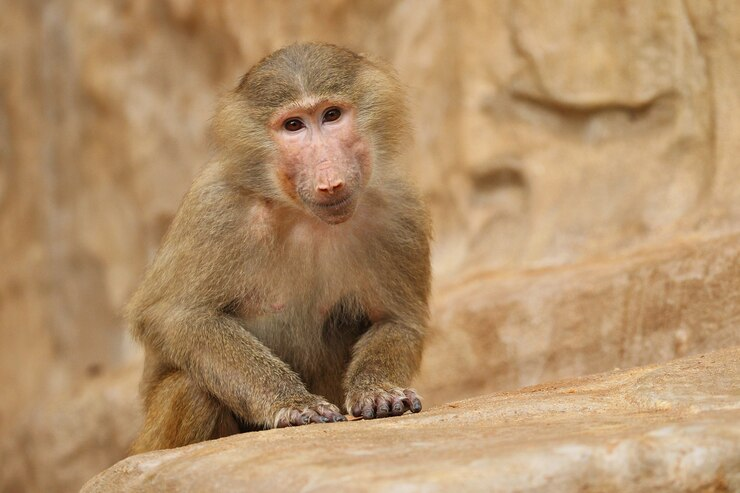
Once the rival feels a female from another harem is quite interested in him, he starts a fight to kidnap his lover so they can mate and live happily ever after, or until the female is attracted to another rival!
If the female happens to have an infant, the rival kidnaps it along with their mother. In such a case, the kidnapped female undergoes some physical changes in a way to stop the rival, her lover, from killing her infant from the previous male.
The Hamadryas Baboon: New harems
How harems form is quite interesting too as they usually merge from one another.
Male followers to the leader of one harem would usually like to move out and start their own harems. So they manipulate young females from their main harem to move out with them to a ‘whole new world’!
If those young females do not give in to the male follower, he might kidnap them. When those new-harem females are old enough to breed, the male follower, who has already become a leader, mates with them to expand his newly-established harem.
Another way followers can get females to join them in their new harem is by attracting the wives of old males within the clan. When those ageing partners are abandoned by their wives, they get so sad that they suddenly lose their social rank in the clan. Sadness also affects them physically as their silver-white hair suddenly turns brown.
Sometimes, followers might even abduct infants from harems. They lure them by encouraging them to ride on their backs. If the infants are lucky, their fathers will come to the rescue and bring them back to their mothers. If they are unlucky, abducted infants may end up dehydrated and dead for no one takes care of them.
The Hamadryas Baboon: Breeding
As we have just demonstrated, harem males mate with their harem females to expand their family. Interestingly, female hamadryas baboons are usually older than males when mating. That is because females are only able to breed when they are five to seven years old while males can mate only when they turn four.
There is not a specific time of year at which hamadryas baboons mate. That means, they can mate at any time of the year. A female is usually pregnant for 5.5 months before she gives birth to a single infant. A female does not give birth again until after 15 to 24 months.
Mothers are responsible for all the parenting. They nurse, groom, and generally take care of their infants. Sometimes, females may groom other females’ infants within the same harem or clan.

On the other hand, the male is responsible for protecting the infants from other males who may try to come closer to them and from predators as well. If followers succeed in kidnapping any of the infants, the male is responsible for bringing them back to the harem.
Interestingly, males also display some other fatherhood qualities by playing with their infants. Oftentimes, males show more patience and gentleness towards their infants than they do towards their wives.
(5) The Largest: African Elephant

Elephants are the largest land animals. They are native to Africa and Asia. However, the African elephant is the largest and the oldest as well. And that is what we are discussing in this section.
The African elephant itself has two species: the African bush elephant being the largest of the two and the African forest elephant is the smallest. They are both found in around 23 countries in Africa including Kenya, Zimbabwe, Zambia, Tanzania, Namibia, and South Africa.
African elephants are extremely short sleepers. They were found to sleep for two hours on average every day.
Unfortunately, the bush elephant is endangered while the forest elephant is critically endangered, making both species at a high risk of going extinct. This is a result of habitat destruction as well as poaching. Poachers hunt the African elephant to illegally sell its ivory tusks.
When not killed by poachers, African elephants can live between 65 and 70 years in the wild. Lifetime expands when the elephants are kept in captivity. It can reach 80 years.
Appearance of the African Elephant
Unlike the greyish-brown Asian elephants, African elephants have grey skin covered with short dark brown or black hair. Female elephants are called cows and males are called bulls. Both genders possess some physical differences.
Bulls are 3.2-4 m tall and weigh 4,700–6,048 kg. On the other hand, females are only up to 2.6 m tall and have a maximum weight of 3,232 kg, being almost half the size of bulls.
The tallest elephant was reported to be 4.21 m at the shoulder and the heaviest individual was found to weigh 10,400 kg. These two were African bush elephants. The African forest elephant weighs up to 4,000 kg and records a maximum shoulder height of 3 m.
African elephants have larger ears than Asian elephants. Such ears can grow to be 1.82 m long and 1.21 m wide. Interestingly, the African elephant ears resemble the shape of the African continent.
Elephants flap their ears like fans to generate air currents and reduce their body temperature. The elephant trunk is a highly sensitive organ that comprises both the nose and the upper lip. Scientists estimate the trunk to have between 4000 and 6000 muscles.
The trunk is used for smelling, touching, feeding, drinking, dusting, and producing sounds as well as in defence and attack. They are so strong that they can carry objects weighing up to 180 kg. When elephants take a swim, they hold their trunks upright outside the water to breathe, just like a breathing tube or a snorkel.
Speaking of the tusks, both males and females grow ivory tusks at the age of one year. In fact, tusks are an elongation of teeth called tushes. Tusks never stop growing. They have a curved shape and can reach a weight of 45 kg at maximum and range in length between 1.5 to 2.4 m.
Like trunks, tusks are used for specific functions. For instance, they are used to dig for roots, tear branches, and remove tree barks which primarily make up the elephants’ diet. Elephants also use them as weapons in fights against other elephants or predators.
The elephant brain was found to weigh a little more than 5 kg, making it the largest brain among all those other land animals.
The African Elephant: Breeding
African elephants are able to breed at the age of 10 to 12 years for females and 15 years for males. Mating usually happens at any time of the year as long as the elephant’s territory is abundant with water. Mating does not often happen when water is scarce.
Females usually have the choice of which male they are going to partner with. This creates aggressive fights among males, in which they use their tusks to win the heart of their beloved females.
Competitions over favoured females get even more common when elephants are 25 years old or more. Larger elephants have a better chance to win such fights and therefore to mate. Females also have a part in starting such fights. Since they need protection, they may subconsciously induce strong males to fight for them. This way females end up mating with stronger and healthier males.
Pregnancy lasts for around 22 months. A female will not give birth again until after three years at the minimum and up to six years at maximum.
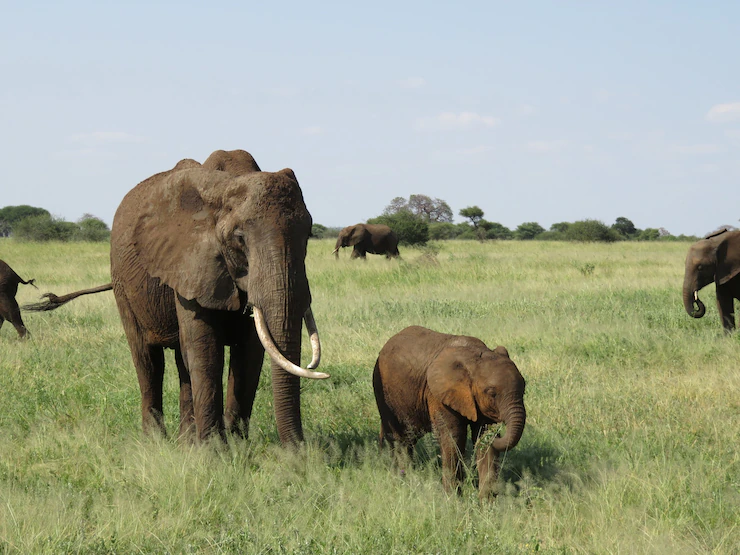
The African Elephant: Society
Females are responsible for all parenting with males stepping away. Unlike the hamadryas baboons who have a primary one-male family, elephants tend to live in female-only families and their offspring.
Every family is led by an older female. Families also join together to form bonds. When male calves grow mature, they often build strong allies with other males within the same family or bond. This is also when they leave the bonds to live solitarily.
Bonds work together to find food and water, protect one another, and take care of offspring. When water is abundant, groups tend to join together to form larger groups. But they tend to separate and stay apart during the dry season.
(6) The Strongest: Gorilla
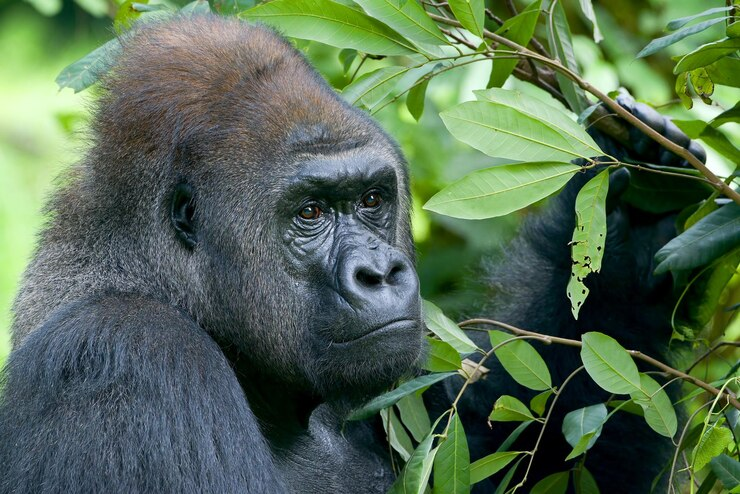
Have you ever seen Disney’s 1999 film Tarzan? Well, I did, several times. It is one of my favourite films. Do you know what I like about the film, besides Tarzan’s story? Gorillas.
And gorillas are what we are discussing in this section, categorised as the strongest land animal.
But like the friendliest animal, a teeny-tiny dispute may arouse over which animal is the strongest. So let’s first clarify what physical strength means. Physical strength is the measure of the force exerted by a human or an animal on physical objects.
Despite gorillas having just higher muscle mass than the average woman and way less than that of an average man, they are much, much stronger than humans. Silverback gorillas have a total body strength of 20 humans.
Though a gorilla would not win a fight against an elephant, gorillas can lift objects as heavy as 10 times their body mass. On the other hand, an African elephant can lift objects weighing up to 320 kg using its highly muscular trunks. That is only 5.3% of the body mass of an elephant.
To sum up, we consider gorillas the strongest land animal. So let’s move on.
What are gorillas, precisely?
Although they look like monkeys, giant monkeys, gorillas are in fact apes. Monkeys and apes are two totally different species, despite having some similarities. One way to tell an ape from a monkey is the tail. Monkeys have tails, gorillas do not. Also, monkeys are smaller than the smallest ape.
Gorillas are; therefore, great apes. They are considered primate animals. That means they are one of the most developed and highly intelligent species. Other primate animals include monkeys and three other scary-looking, hard-to-pronounce animal species called lemurs, lorises, and tarsiers. Humans are also primate creatures.
Primate animals are distinct for their large, complex brains. They also have an extremely sharp sense of sight. It makes them able to see in colour. They can also use their hands skillfully.
So all in all, gorillas are great apes.
Gorillas are native to Africa, precisely inhibiting the tropical forest around the Equator. There are two main species of gorilla: the eastern gorilla and the western gorilla. The main difference, yes, you guessed it, is that the eastern gorillas live to the east of Africa and vice versa. Western gorillas live in the west of Africa.
Both species, however, inhibit central Africa.
That said, there are also some main physical differences between the two species.
One of such differences is the fur colour. Eastern gorillas are darker than western gorillas which can sometimes be brown or greyish. Eastern gorillas also have longer faces and broader chests. Eastern gorillas have fewer members left in the wild estimated to be 5,000 members only. On the other hand, western gorillas are thought to be 316,000.
Gorillas live between 35 and 40 years in the wild. When being taken care of by humans, they can live up to 50 years old and sometimes even longer than that. The longest-living known gorilla was a western female gorilla who died at the age of 61 in January 2022.
Unfortunately, gorillas are critically endangered. That means they are facing a high risk of going extinct as long as they are in the wild. Such a high risk resulted from poaching, destruction of habitat, and diseases.
Another distinct feature about gorillas which they share with chimpanzees and orangutans is nest building. Gorillas use tree branches and leaves to build land nests where they spend some of their daytime and sleep at night. In general, gorillas move out of their mothers’ nests at the age of three to build their own nests. But still, they keep them close to their mothers’ nests.
Gorillas are one highly intelligent species. As we have seen, they develop strong family bonds. Gorillas also laugh, show sadness, and generally express different emotions. They are also able to use tools.
Appearance of the Gorilla
Besides being the strongest land animal, gorillas are the largest primate. Adult males weigh between 136 to 227 kg and are 1.4 to 1.8 m tall with their arms stretching, from tip to tip, for a maximum of 2.6 m. On the other hand, female gorillas have a body weight range of 65-113 kg and are 1.25 to 1.5 m tall.
The tallest gorilla was found to be 1.95 m tall and had an arm span of 2.7 m. The heaviest gorilla weighed 264 kg. When gorillas are kept in captivity, they get much heavier than that. Since they do not move or lift things as much, they can reach up to 310 kg.
Interestingly, gorillas have fingerprints which is something they share with humans, chimpanzees, and even koalas!
Gorillas walk mostly on their knuckles but that does not happen all the time. They also walk upright, especially when they get into a fight or when they are carrying food.
By the age of 12, male gorillas develop silver hair that covers their backs. This gives them the name silverbacks. So a silverback is a male gorilla at 12 years or more of age.
The Gorilla: Feeding
One might think that an animal as huge and powerful as a gorilla must be a meat-eater. However, that is not always true. Gorillas are, in fact, plant-eating animals. Their diet mainly comprises leaves and pith. Some eastern gorillas subspecies known as mountain gorillas do not eat fruits as much. While eastern lowland gorillas have fruits make up 25% of their diet.
On the other hand, western gorillas eat a lot of fruits as well as termites and ants. Strangely, gorillas rarely drink water as the food they consume contains a lot of it.
The Gorilla: Breeding
Male and female gorillas grow mature and can breed at the age of 11-13 years and 10-12 years respectively. Unlike many other animals, gorillas mate at any time of the year. A female stays pregnant for approximately 257 days then she gives birth to a single infant. On very rare occasions, females may give birth to twins.
Mothers do most of the parenting. They feed their infants, protect them, groom them, and play with them. For the first five months or so, infants stay in contact with their mothers. After that, they start to gradually go further and spend more and more time away from them.
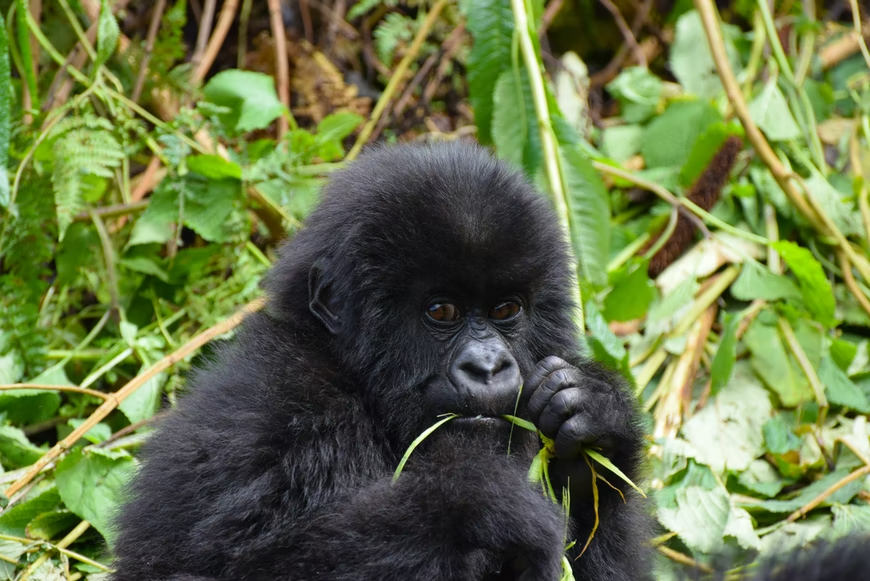
The Gorilla: Society
Like the hamadryas baboons we discussed earlier, gorillas also form small communities. The main unit of the gorilla’s society is the troop, comprising one or multiple silverbacks, females, and their offspring.
That said, the gorilla troop is less conservative and strict than a hamadryas baboon’s harem. While female hamadryas baboons cannot go away from the borders earlier determined by the harem male, female gorillas can leave their troops to join other groups, mostly new ones.
In addition, adult male gorillas also tend to leave their troop to establish their own troops. They attract migrating females to join those new troops.
Like Kerchak in Tarzan, the silverback is the leader and the one who controls everything related to the troop. He makes decisions, and chooses where the troop members will look for food, and how far they should go. He splits conflicts and disputes in the troop, protects it, and takes care of its members.
Sometimes, there are other younger males in the group. Those are not silverbacks and they mostly serve as followers or subordinates of the leader.
Females in the troop try to maintain strong relationships with the silverback to stay safe and secure their future mating opportunities. Females also keep good relationships with other relative females within the same troop. They spend time together, act friendly, and sometimes take care of each other’s infants. If females are not related, they tend to show aggressive behaviour toward one another.
When the silverback mates with a female, he does not do as much in taking care of the infant. Yet, they play a role in their education and development as adult gorillas. For instance, they help introduce and socialise the infants with other young members of the troop who they may be related to. The silverback also stops his infants from going into aggressive fights with others; thus teaching them to behave.
Conclusion
And so we get to the end of today’s journey.
In this article, we have demonstrated six extraordinary animals, three of which are native to Central and South America while the remaining three are exclusively found in Africa. From the tallest ever, the slowest, the friendliest, the longest-living monkey largest, and the strongest, they are all marvellously unique.
We learned some interesting information about those five animals, starting from their appearance, what they eat, where they live, and when they mate. We also discussed the traits that make them distinctive.
We hope you found this information interesting as much as we loved writing to you about it. And if you happened to see any of those incredible animals in real life, why do you not tell us about your experience in the comments?
If you enjoyed learning about this facinating animal why not check out more fantastic facts about other animals: Koalas, Sharks, Raccoons, Moon and Sun Bears, Rats, Sheep, Chickens, Cats, Pandas, Monkeys and Whales.
Why not subscribe for as little as £1.99 per month to access over 1000 fun educational videos!


Leave a Reply